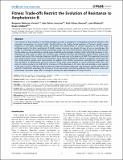Fitness Trade-offs Restrict the Evolution of Resistance to Amphotericin B
Author(s)
Vincent, Benjamin Matteson; Lancaster, Alex K.; Scherz-Shouval, Ruth; Whitesell, Luke; Lindquist, Susan
DownloadVincent-2013-Fitness trade-offs r.pdf (2.161Mb)
PUBLISHER_CC
Publisher with Creative Commons License
Creative Commons Attribution
Terms of use
Metadata
Show full item recordAbstract
The evolution of drug resistance in microbial pathogens provides a paradigm for investigating evolutionary dynamics with important consequences for human health. Candida albicans, the leading fungal pathogen of humans, rapidly evolves resistance to two major antifungal classes, the triazoles and echinocandins. In contrast, resistance to the third major antifungal used in the clinic, amphotericin B (AmB), remains extremely rare despite 50 years of use as monotherapy. We sought to understand this long-standing evolutionary puzzle. We used whole genome sequencing of rare AmB-resistant clinical isolates as well as laboratory-evolved strains to identify and investigate mutations that confer AmB resistance in vitro. Resistance to AmB came at a great cost. Mutations that conferred resistance simultaneously created diverse stresses that required high levels of the molecular chaperone Hsp90 for survival, even in the absence of AmB. This requirement stemmed from severe internal stresses caused by the mutations, which drastically diminished tolerance to external stresses from the host. AmB-resistant mutants were hypersensitive to oxidative stress, febrile temperatures, and killing by neutrophils and also had defects in filamentation and tissue invasion. These strains were avirulent in a mouse infection model. Thus, the costs of evolving resistance to AmB limit the emergence of this phenotype in the clinic. Our work provides a vivid example of the ways in which conflicting selective pressures shape evolutionary trajectories and illustrates another mechanism by which the Hsp90 buffer potentiates the emergence of new phenotypes. Developing antibiotics that deliberately create such evolutionary constraints might offer a strategy for limiting the rapid emergence of drug resistance.
Date issued
2013-10Department
move to dc.description.sponsorship; Massachusetts Institute of Technology. Department of Biology; Whitehead Institute for Biomedical ResearchJournal
PLoS Biology
Publisher
Public Library of Science
Citation
Vincent, Benjamin Matteson, Alex Kelvin Lancaster, Ruth Scherz-Shouval, Luke Whitesell, and Susan Lindquist. “Fitness Trade-offs Restrict the Evolution of Resistance to Amphotericin B.” Edited by Aaron P. Mitchell. PLoS Biology 11, no. 10 (October 29, 2013): e1001692.
Version: Final published version
ISSN
1545-7885
1544-9173